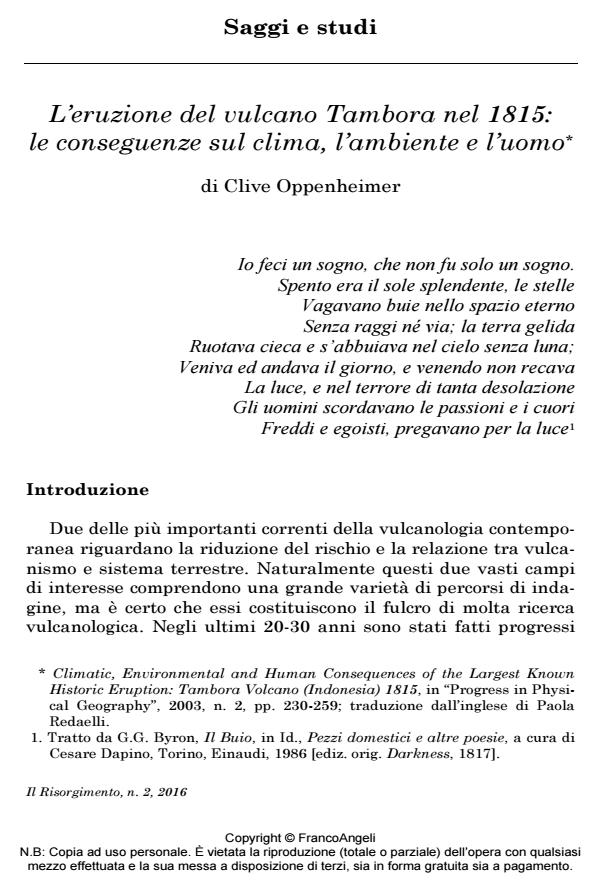The 1815 eruption of Tambora volcano: climatic, environmental and human consequences.
Journal title IL RISORGIMENTO
Author/s Clive Oppenheimer
Publishing Year 2017 Issue 2016/2
Language Italian Pages 47 P. 7-53 File size 746 KB
DOI 10.3280/RISO2016-002001
DOI is like a bar code for intellectual property: to have more infomation
click here

FrancoAngeli is member of Publishers International Linking Association, Inc (PILA), a not-for-profit association which run the CrossRef service enabling links to and from online scholarly content.
The 1815 eruption of Tambora volcano (Sumbawa island, Indonesia) expelled around 140 gt of magma (equivalent to ≈50 km3 of dense rock), making it the largest known historic eruption. More than 95% by mass of the ejecta was erupted as pyroclastic flows, but 40% by mass of the material in these flows ended up as ash fallout from the "Phoenix" clouds that lofted above the flows during their emplacement. Although they made only a minor contribution to the total magnitude of the eruption, the short-lived plinian explosions that preceded the climactic eruption and caldera collapse were powerful, propelling plumes up to 43 km altitude. Over 61.000 people died during, or in the aftermath of, the eruption, on Sumbawa and the neighbouring island of Lombok. The eruption injected ≈60 m of sulfur into the stratosphere, six times more than was released by the 1991 Pinatubo eruption. This formed a global sulfate aerosol veil in the stratosphere, which resulted in pronounced climate perturbations. Anomalously cold weather hit the northeastern Usa, maritime provinces of Canada, and Europe the following year. 1816 came to be known as the "Year without a summer" in these regions. Crop failures were widespread and the eruption has been implicated in accelerated emigration from New England, and widespread outbreaks of epidemic typhus. These events provide important insights into the volcanic forcing of climate, and the global risk of future eruptions on this scale.
L’eruzione nel 1815 del vulcano Tambora, in Indonesia, che espulse 140 gt di magma (≈50 km3 di roccia densa equivalente, DRE), fu la più grande eruzione della storia. Più del 95% delle emissioni consistette in flussi piroclastici, ma il 40% della massa del materiale di questi ultimi risultò essere una caduta di ceneri dalle nubi di tipo Phoenix sprigionatesi dai flussi mentre si depositavano, che contribuirono solo in misura ridotta alla magnitudo totale dell’eruzione. Tuttavia, le brevi esplosioni pliniane che precedettero l’eruzione critica e il collasso della caldera furono potenti, e spinsero le colonne fino a 43 km di altitudine. Più di 61.000 persone morirono durante o immediatamente dopo l’eruzione, a Sumbawa e nella vicina isola di Lombok. L’eruzione emise ≈60 m di zolfo nella stratosfera, una quantità sei volte superiore a quella rilasciata dall’eruzione del Pinatubo nel 1991. Ciò diede luogo a un velo di aerosol di solfati nella stratosfera, che si tradusse in significative perturbazioni del clima. L’anno seguente, un freddo anomalo colpì le regioni nordorientali degli Usa, quelle canadesi che si affacciano sull’Atlantico e l’Europa. Da allora il 1816, in queste zone, è noto come "l’anno senza estate". I raccolti fallirono quasi ovunque e si è chiamata in causa l’eruzione per spiegare l’accelerazione dell’emigrazione dal New England e il diffuso insorgere di epidemie di tifo. Questi fenomeni forniscono elementi di conoscenza fondamentali circa le trasformazioni climatiche indotte dall’attività vulcanica e il rischio globale connesso a eruzioni vulcaniche di queste dimensioni.
Keywords: Atmosphere, climate, Tambora 1815, volcano, "Year wi-thout a summer"
Clive Oppenheimer, L’eruzione del vulcano Tambora nel 1815: le conseguenze sul clima, l’ambiente e l’uomo in "IL RISORGIMENTO" 2/2016, pp 7-53, DOI: 10.3280/RISO2016-002001